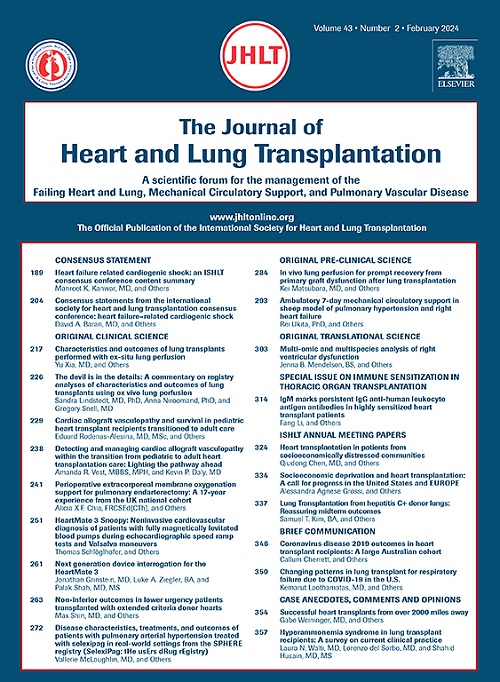Video kinematics of an unloaded, ex-vivo beating heart can predict future loaded heart function
IF 6
1区 医学
Q1 CARDIAC & CARDIOVASCULAR SYSTEMS
引用次数: 0
Abstract
There is not a reliable biomarker for identifying which hearts are at highest risk for primary graft dysfunction. We hypothesize that ex-vivo video kinematics (EVVK) of unloaded beating hearts can help predict post-implant heart performance. Porcine hearts procured following a DCD protocol were re-animated in unloaded ex situ heart perfusion (ESHP) before transitioning to a loaded configuration. Five second videos were recorded using a consumer cell phone. Machine learning EVVK software was developed to autonomously quantify heart function. Of 22 porcine hearts, 6 (27%) did not tolerate loading. EVVK demonstrated prognostic capability to differentiate the future loaded performance in terms of both compliance (p=0.004) and contractility (p=0.003). We also demonstrate proof-of-concept in using EVVK on human hearts (n=4) to provide a quantitative functional assessment of the allograft during transportation from the donor to recipient center. Overall, non-invasive EVVK may be able to aid clinicians in quantitative heart evaluation.
视频运动学的卸载,离体跳动的心脏可以预测未来负荷心脏功能。
目前还没有一个可靠的生物标志物来确定哪些心脏有最高的原发性移植物功能障碍风险。我们假设卸载跳动心脏的离体视频运动学(EVVK)可以帮助预测植入后的心脏表现。根据DCD方案获得的猪心脏在过渡到加载配置之前,在卸载的非原位心脏灌注(ESHP)中重新激活。他们用消费者手机录制了五秒钟的视频。开发了机器学习软件EVVK,自动量化心功能。在22只猪心脏中,有6只(27%)不能耐受负荷。EVVK显示了在依从性(p=0.004)和收缩性(p=0.003)方面区分未来负载性能的预后能力。我们还演示了在人类心脏(n=4)上使用EVVK的概念验证,以提供从供体到受体中心运输过程中同种异体移植物的定量功能评估。总的来说,无创EVVK可以帮助临床医生进行心脏定量评估。
本文章由计算机程序翻译,如有差异,请以英文原文为准。
求助全文
约1分钟内获得全文
求助全文
来源期刊
CiteScore
10.10
自引率
6.70%
发文量
1667
审稿时长
69 days
期刊介绍:
The Journal of Heart and Lung Transplantation, the official publication of the International Society for Heart and Lung Transplantation, brings readers essential scholarly and timely information in the field of cardio-pulmonary transplantation, mechanical and biological support of the failing heart, advanced lung disease (including pulmonary vascular disease) and cell replacement therapy. Importantly, the journal also serves as a medium of communication of pre-clinical sciences in all these rapidly expanding areas.

 求助内容:
求助内容: 应助结果提醒方式:
应助结果提醒方式:


